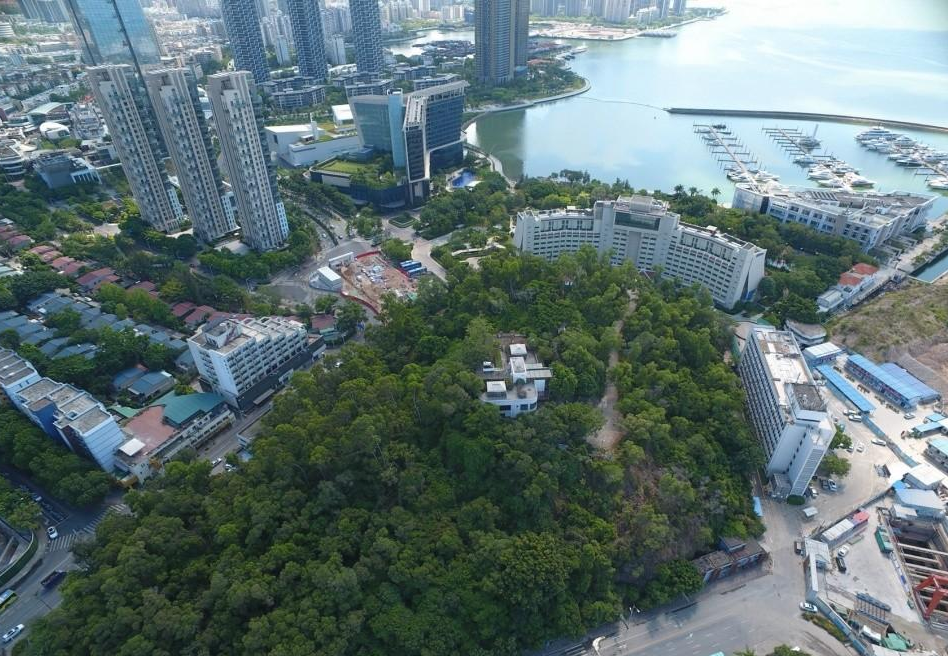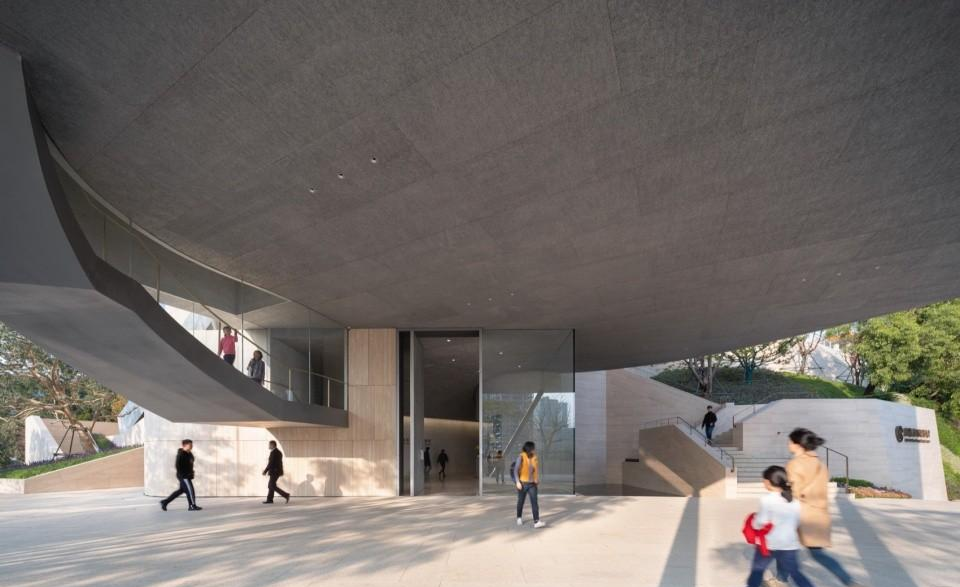二十世纪七十年代末,中国转向以经济建设为中心,深圳成为中国第一个经济特区。香港招商局率先来到深圳创办蛇口工业区,在深圳南头半岛开山炸石填海建港,对外招商引资,成为中国改革开放的先行者。工业区成功的运营机制随后被称为 “蛇口模式”,为之后中国40年的经济腾飞拉开了序幕。招商局成立于清末的1872年,又经历了民国和共和国三个时代的跌宕起伏,为迎接150年华诞,选址蛇口微波山建造招商局历史博物馆。
At the end of the 1970s, China shifted its focus to economic development, with Shenzhen becoming the first Special Economic Zone. The China Merchants Group from Hong Kong took the lead in establishing Shekou Industrial Zone in Shenzhen. They blasted the hilly terrain, reclaimed the sea to build ports, and attracted foreign investment, making it a pioneer in China’s Reform and Opening-up. The successful operational mechanism of the industrial zone became known as the “Shekou Model”, which set the stage for China’s 40 years of economic takeoff. The China Merchants Group, founded in the late Qing Dynasty in 1872, went through the ups and downs of the Republic period and then the PRC, decided to build the China Merchants History Museum on top of the seaside hill of Weiboshan in Shekou to celebrate its 150th anniversary.
▼北向鸟瞰远景,North arial view

▼位于叙事步道的1992景观构筑物,The 1992 Pavilion on the narrative walkway

▼南向鸟瞰远,South arial view

微波山原为蛇口一座无名小山头,因山顶上修建了中国第一个商用微波站而得名。都市实践应邀设计招商局历史博物馆,提出“山即展场,城即展览”的设计理念,将整座微波山公园作为一个空间叙事整体。从山脚的“时间广场”展开叙事,这里是象征改革开放肇始的“蛇口开山炮”炸响的现场,广场中央的纪念碑上镌刻着工业区创建者袁庚先生被视为凝聚深圳精神的名言 “时间就是金钱,效率就是生命”。拾级而上,改革开放历史的重要事件被刻录在环山的叙事步道中,并且与周边的城市景观呼应,呈现历史今夕的并置,形成多个景观节点。登山成为观展的一部分,至山顶博物馆达到展览叙事的高潮。
▼区位分析,Site analysis

▼基地照片,Site photo

Weiboshan was originally an unnamed hill in Shekou, and later named after the construction of China’s first terrestrial microwave relay station on its peak. URBANUS was invited to design the China Merchants History Museum and proposed a concept of “the hill as the exhibition venue, and the city as the exhibition”, treating the entire Weiboshan Park as one unified spatial narrative. Starting from the “Time Square” at the foot of the hill, this site symbolizes the beginning of China‘s Reform and Opening-up as it is where the “Shekou Mountain-Blasting ” detonated. The monument at the center of the square is engraved with a famous saying of Yuan Geng, the leader in building the industrial zone, which is regarded as embodying the spirit of Shenzhen: “Time is money, efficiency is life”. As one climbs up, significant events in the history of Reform and Opening-up are inscribed on the narrative walkway around the hill, resonating with the surrounding urban landscape and juxtaposing historical and contemporary scenes. This design creates multiple scenic nodes, integrating the climb into the exhibition experience. The ascent culminates at the hilltop museum, simultaneously reaching the climax of the exhibition narrative.
▼西北向鸟瞰,North-west arial view

▼南向鸟瞰,South arial view

▼南侧外立面,South façade of the museum

▼北侧外立面,North façade of the museum

▼南侧外立面,South façade of the museum

博物馆的设计从微波站原址的考证开始,经过比对历史图纸和现场勘察,在经历了多次加建的现场建筑中找到了当年微波站的原始结构。方案恢复了微波站的原貌,加固了基础,让它以“现成品”的姿态成为馆中最具历史意义的展品。
▼历史照片,Historic photos

▼被保留的微波通讯站原始结构,Preserved foundation of the old microwave communication station

▼孟岩手绘草图,Sketch by Meng Yan

The design of the museum began with an investigation of the original site of the terrestrial microwave relay station. By comparing historical drawings and conducting on-site surveys, the original structure of the station was identified within the existing buildings. By peeling off the additional walls added through multiple renovations, the original building was restored, and the foundation was reinforced, making it the most historically significant exhibit in the museum—a “ready-made” artifact.
▼西侧室外楼梯,Outdoor stairs on the west

▼建筑西侧外观,West side of the museum

▼主入口东侧,East of entry plaza

▼主入口及入口广场,Entry plaza

▼三层(架空)观景平台西侧,West side of the third floor viewing terrace

▼三层(架空)观景平台西北侧,North-west side of the third floor viewing terrace

▼三层(架空)观景平台东侧,East side of the third floor viewing terrace

▼三层与四层天井,Light well on the third floor

▼天井局部,Partial view of the light well

▼天井螺旋楼梯,Light well and spiral stairs

博物馆建筑共五层。半地下层设置了主入口、门厅、小型接待室以及主要设备机房,还设置了一个可在闭馆时独立开放的多动能厅;一、二层围绕复原的微波站布置了招商局150周年历史的常设展厅。三层架空层是向公众开放的观景平台,连接登山步道。这里设有咖啡厅/接待室,可用于会议和沙龙。人们可在室内外闲坐,360度观看蛇口的半岛风光,见证进行时中的蛇口这一“城市展场”;四层为当代艺术展厅,漂浮的体量之内是连续环绕的展览空间,用于短期主题展览。面向不同方位形态各异的窗口是望向场地四周自然及城市的景框,将变化的城市风景纳入到展览的序列中。屋顶是一个开阔的观景平台,也是微波山的最高点,是极目远眺和举办露天活动的场所。设计在室内观展流线之外还设置了多条室外公共流线,让市民在闭馆后仍有机会拾级而上。层次丰富立体的游览体验使博物馆能适应多种展陈与活动的需求。
▼分解轴测图,Exploded axonometric

There are five levels in the museum. The semi-basement level includes the main entrance, lobby, a small reception room, and the main equipment room, as well as a multifunctional hall that can be independently opened when the museum is closed. The first and second floors feature permanent exhibition centered around the restored station, showcasing the 150-year history of the China Merchants Group. The third floor is an open-air viewing platform accessible to the public and connected to the climbing trail. This floor includes a café/reception room for meetings and salons. Visitors can sit indoors or outdoors, enjoying a 360-degree view of the Shekou Peninsula, and experiencing Shekou as an “urban exhibition hall” in real time. The fourth floor houses a contemporary art gallery. Within its floating structure is a continuous, wrap-around exhibition space for short-term themed exhibitions. The variously shaped windows on different facades frame the surrounding natural and urban landscapes, incorporating the changing city scenery into the exhibition sequence. The roof is a spacious viewing platform, also the highest point of Weiboshan, providing a place for distant views and outdoor activities. In addition to the indoor exhibition routes, multiple outdoor public pathways are set up, allowing citizens to climb the steps even when the museum is closed. The rich and multi-dimensional touring experience enables the museum to accommodate various exhibition and event needs.
▼前厅,Lobby


▼前厅弧形楼梯,Curved staircase in the lobby

▼原微波站改造展厅,Preserved microwave communication station as exhibition space


▼地下一层室内斜坡,Interior on the basement

▼水滴楼梯俯视,Drop-shaped interior stairs

▼四层展厅西侧,West side of the fourth floor exhibition hall

▼四层通向屋顶旋转楼梯,Spiral stairs from the fourth floor to the roof

▼四层通往屋顶弧型楼梯,Curved stairs from the fourth floor to the roof

博物馆的外立面材料以白洞石为主,建筑体量局部埋入山体,像是山的一部分。室内材料及工艺细腻地呼应了招商局的工业历史,使用铸铝件、铜、钢和混凝土等元素。建筑入口超常规尺寸的大门采用铸铝制造,重要空间的墙面则将工业零件作为骨料的一部分掺入混凝土中一同浇筑。
The museum’s facade is primarily clad with white travertine. As parts of the building are embedded into the hill, it appears as a natural extension of the landscape. The interior materials and craftsmanship meticulously reflect the industrial history of the China Merchants Group, incorporating elements such as cast aluminum, steel, copper and concrete. The oversized entrance door is made of cast aluminum, and the walls of important spaces are cast with concrete that includes industrial components as part of the aggregate.
▼屋顶,Rooftop

▼建筑细节,Material and detail


招商局历史博物馆不是一座普通的博物馆,它标志着中国当代历史的一个重要转折点, 也是传承与弘扬改革开放精神的空间场所。我们试图将一座里程碑式的纪念性建筑与普通市民的日常生活紧密结合,创造属于当下的公共空间和城市记忆,人们登临微波山,看天空海阔,同时在这里回顾历史,展望未来,缅怀先贤,激励后人;让微波山这个大隐于市的秘境成为深圳城市精神地标和市民日常文化生活锚点。
The China Merchants History Museum is not an ordinary museum; it marks an important turning point in contemporary Chinese history and serves as a space to inherit and promote the spirit of Reform and Opening -up. We aimed to closely integrate this milestone commemorative building with the daily lives of ordinary citizens, creating a public space and urban memory that belong to the present. People can climb Weiboshan, gaze at the vast sky and sea, review history, look to the future, pay tribute to pioneers, and inspire future generations. This hidden gem within the city shall become a landmark of Shenzhen’s urban spirit and a cultural anchor for the daily lives of its citizens.
▼建筑东南侧外观,South-west view

▼东南向鸟瞰远景,South-east arial view

▼建筑西南侧外观,South-west view

▼剖面图,Section

